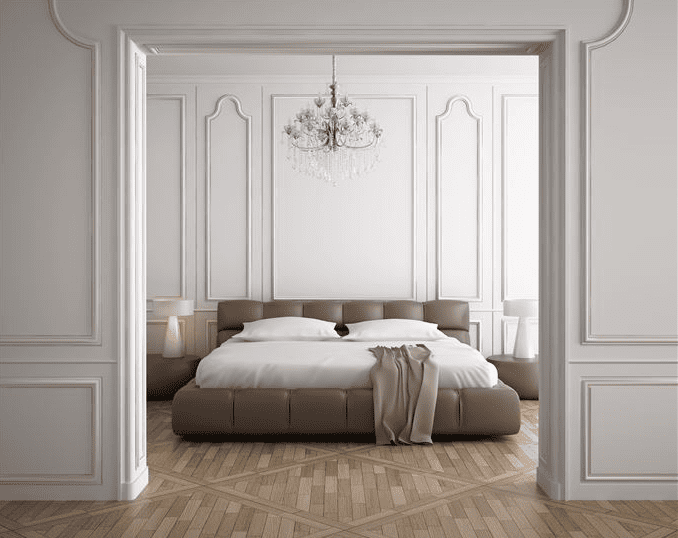The Answers You Need to the Top 10 Questions About Wainscoting

Even if you feel unfamiliar with the term “wainscoting,” it is likely that you have seen this type of wood paneling in a home or office building. For centuries, builders and homeowners have installed wainscoting to protect their walls from chair or table damage, scuff marks from footwear, and other damaging elements.
Want to know more about why the use of wainscot paneling never faded? The answers you need to the top ten questions we often get asked about wainscoting are here. Continue reading for more information on how the wainscot paneling trend started and what purposes wainscoting serves today. You will also learn about the modern and traditional wainscot paneling options that we offer today at The Moulding Company.
1. What is Wainscoting?
Wainscoting is a decorative and functional system of wood panels, chair railing (framing), and moulding. However, the wainscot paneling that we know today originated in the 18th century. That’s when wainscot paneling was no longer installed as floor-to-ceiling paneling, and began covering just the lower half of walls. Wainscot paneling was initially functional rather than decorative—adding interior protection and insulation from damp and cold stone walls.
2. Why is it Called Wainscoting?
While the debate remains as to the exact origin of the term “wainscoting,” it most likely derives from the German word for “wall-board.” The wood for wainscot paneling originally came from a specific type of oak tree that became known as “wainscoting oak.” Even after the type of wood commonly used for wainscot paneling changed, the term “wainscoting” stuck with the wall panels.
3. What is the Purpose of Wainscot Paneling?
Wainscot paneling still serves multiple purposes—as wall protection and added home décor. Today, wainscot paneling is a classic design choice that adds richness to your home. You can use wainscot paneling to add a subtle texture or go bold with a pop of color or intricate design. As an element of home décor, these wall coverings can transform a dull room while also adding functional protection for your walls at the same time.
4. Is Wainscoting Paneling Expensive?
The cost of wainscot paneling depends on several factors—materials chosen, square footage needed, custom design elements, and installation. Traditional wainscoting materials included sturdy, non-decorative hardwoods, but today these wall panels come in a variety of materials and styles.
Stop in one of our San Francisco Bay area showrooms to see for yourself how traditional wainscoting or raised panel wainscoting can enhance any room in your home! We offer material, paint, and stain options to match any home’s interior design elements.
5. What are the Different Types of Wainscot Paneling?
Some popular types of wainscot paneling are tongue and groove beadboard, picture frame-style, raised panel, and personalized or customized designs. While there are many wainscoting styles to choose from, you may find that only a few make sense for your home and taste.
Reach out to the experts here at The Moulding Company and let us walk you through the design process. We will make sure you get the best style for your home!
6. Are Wainscoting and Beadboard the Same Thing?
While beadboard is a style of panel used in wainscoting, it is also a common design element in many other home décor projects—such as upgrading your boring basement décor or adding overall elegance to your home.
7. Can Wainscot Paneling be Painted?
You can paint or stain your wainscot paneling to match your home’s décor or to have it stand out as an accent piece. However, the material you choose for your wainscoting may determine how you can paint or stain your wainscoting.
It is best to consult an expert before painting any existing wainscoting you have in your home, or before installing new wainscoting. An expert can help you determine the right paint or stain you can use, or show you available options for your new wainscoting.
8. Can Wainscot Paneling be Sanded?
In short, you can sand your wainscot paneling. Generally, before you paint or stain any wood décor, you want to sand down the old paint or stain. But just like the answer above, make sure you consult a professional who will assess your in-home wainscoting to make sure it can withstand such an upgrade.
9. How Do You Install Wainscoting?
Since there are several styles of wainscot paneling, the time and skill involved to install each differs between types. If you are handy, installing wainscoting may be a project you can tackle. However, if you’re looking to have a professional installation completed and a guarantee or proper workmanship, reach out to us at The Moulding Company. Our knowledgeable staff can answer all of your questions!
10. Can Wainscoting Get Wet?
Wainscot paneling can get wet, but depending on the type of material and paint you select, the amount of moisture your wainscoting can handle will vary. In-home wainscot panels generally deal with splashes or spills, and that type of moisture will not do any significant damage. However, wainscoting is not often suitable in wet locations like bathrooms, especially if you DIY install.
If you plan to use wainscoting in your bathroom, make sure you invest in a professional installation. A professional will make sure to seal your wall panels for such a humid area properly.
Additionally, make sure you don’t allow any spills or splashes to pool around your wainscoting framework or moulding, as that could lead to damage.
Visit One of Our Showrooms to See Your Wainscoting Options
If you are ready to enhance a room in your house with wainscoting, we have got you covered with our extensive catalog of wainscot paneling related products. Visit one of our showroom locations in San Francisco, CA, to see our wainscot paneling options and speak with our expert team on how to get started with your next project.
